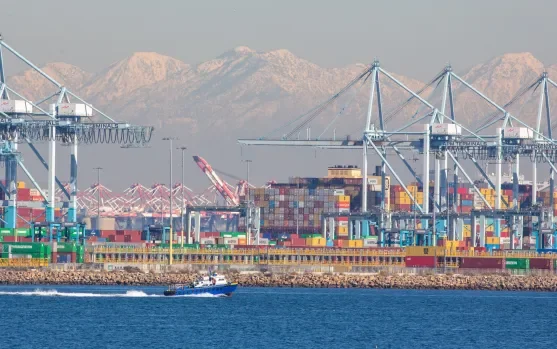
Search our collection of articles, blogs, resources and more to stay informed on the goods movement sector.
WSC Launches Global Dual-Fuel Fleet Dashboard
The World Shipping Council has launched its Dual-Fuel Fleet Dashboard, which monitors the global liner fleet’s transition to renewable and lower-emission fuels. As of September 2025, more than 350 dual-fuel container ships and vehicle carriers are active, with orders accelerating toward a low-carbon future. Explore the trends shaping shipping decarbonization.
September 2025 Report on Containerized Trade at North American Seaports
In September 2025, the Ports of Los Angeles and Long Beach saw declines in container volumes year-over-year, but still posted gains compared to 2019. Other major U.S. and Canadian seaports showed divergent trends. Explore full port comparisons and regional performance in this latest analysis.
Clean Air, Quality Jobs, Affordable Goods: The Collaborative Path for Southern California’s Ports
By Paul Granillo, President & CEO, Inland Empire Economic Partnership
California ports lead in clean air progress. Learn how collaboration, not regulation, is driving zero-emission supply chains and economic strength.
Preliminary August 2025 TEUs
In August 2025, San Pedro Bay ports handled 944,832 inbound loaded TEUs, a 2.2% decrease from the previous year but a 24.3% increase from 2019.
Black Swans and Container Forecasts
By Jock O’Connell, Economist
Black swan events—unpredictable, high-impact disruptions such as strikes, cyberattacks, and maritime crises—are reshaping container shipping and global supply chains. Learn how ports, shippers, and logistics operators are adapting forecasts and strategies to build resilience against these rare but costly events.
The Warehouse ISR Experiment: High Costs, No Gains – Why California Must Avoid Indirect Source Rule Expansion
By Tim Jemal, CEO, Supply Chain Federation
A Ramboll study commissioned by the Supply Chain Federation finds California’s Warehouse ISR adds high costs with no emission gains—threatening jobs & supply chains.
Preliminary July 2025 TEUs
July 2025 TEU report: LA and Long Beach hit record volumes while Oakland and Vancouver surge. Explore U.S., Canada & Mexico port trends.
Local Primary in Seattle Provides Shock and Awe Moment for Moderate Incumbents
Jordan Royer, Vice President of PMSA
Seattle’s August 2025 primary delivers shocking losses for moderate incumbents, raising questions about progressive momentum and national political shifts.
The China Trade
USWC ports see steep drop in China trade—imports down over 25% and exports off more than 65% since pre-COVID levels.
A Path Forward to Cleaner Air at the Ports
By Gene Seroka & Mario Cordero, Port of Los Angeles, Port of Long Beach
Ports of LA & Long Beach propose ‘CAAP Plus’—a cooperative, enforceable plan to cut port emissions faster than SCAQMD’s PR 2304 rulemaking approach.
Trucking a Container in California Can Cost 35% More Per Gallon of Diesel Than in Houston
California truckers face record diesel prices, paying 35% more than Houston and far above East Coast and Gulf Coast averages. Diesel for drayage in California tops $5/gal, driving up trucking costs at LA, Long Beach, and Oakland ports.
That Big Box on the Road
The story behind 53-foot containers on U.S. highways—how the 1982 STAA law and Rep. Glenn Anderson changed trucking forever.
The Lumpy USWC Share of Recent U.S. Container Trade
West Coast ports see volatile market share in U.S. container trade as tariffs, labor risks, and East Asia imports drive shifting cargo flows.
The Mistakes of the Past, the Opportunities of the Future
Thomas Jelenić, Vice President of PMSA
Southern California regulators are about to repeat the environmental policy mistakes California has made on grand scale. For decades, California was a leader in reducing pollution from mobile sources. It is important to stress the word “leader” here.
Who’s Number One?
Normally, the Port of Los Angeles is the nation’s busiest container gateway. Still, from time to time, the Port of New York/New Jersey (PNYNJ) lays claim to the title, invariably causing the East Coast media to break out the celebratory sparklers. The contest for the nation’s top container port is typically framed in the media as a rivalry between PNYNJ and the Port of LA, the Yankees vs. the Dodgers, if you will.




















